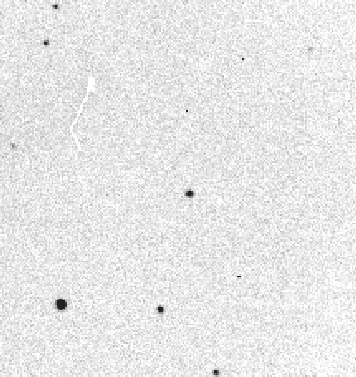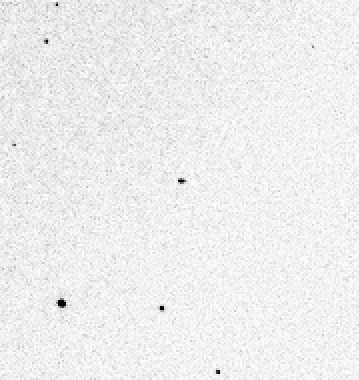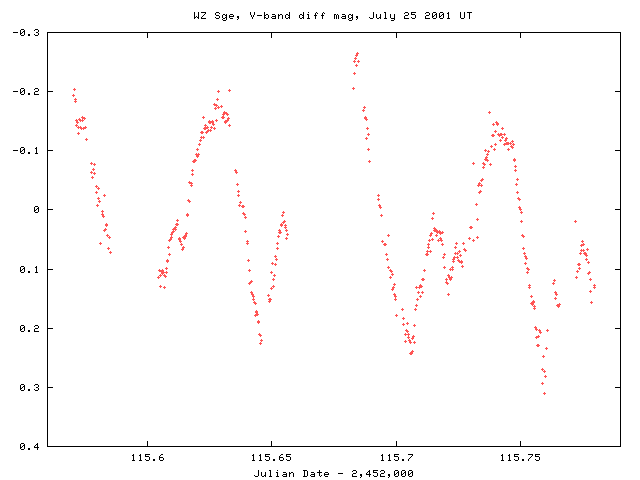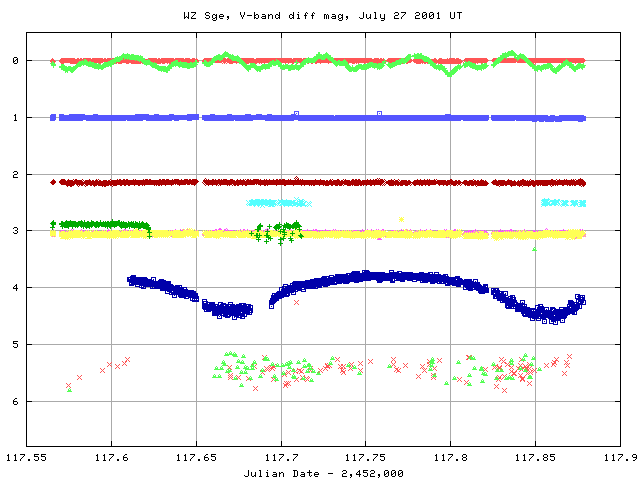Acquiring an Observatory Code
The International Astronomical Union, astronomy's governing body, sponsors several stations around the world. One of them is located on the campus of Harvard University: it houses the Minor Planet Center (MPC), which coordinates observations of comets and asteroids, and the Central Bureau for Astronomical Telegrams, which publishes short messages every day or two with news on time-critical events. The MPC maintains a list of observatories around the world. In order to be placed on the list, an observatory must prove that it can produce competent astrometric results.
While we were waiting for the new camera to arrive, we used our old CCD camera to take images of a known asteroid, 2000 QW7. On the nights of Sept. 5 and 7, 2000, we acquired images of this asteroid as it passed relatively close to the Earth. We derived positions for the asteroid based on the images, and sent them to the MPC on Sept 11, 2000. The next day, the MPC verified that our measurements were accurate, and granted the RIT Observatory code number 920. Our measurements were published in Minor Planet Circular 41155, Sept. 13, 2000.
Using this code, we can access a number of observing programs coordinated by the MPC which are available only to "those astrometric observers who have a proven track record of producing reliable astrometry," (in the words of the MPC).
Collaborating with the USNA to measure parallax
Parallax is the apparent shift in position of an object when one observes it from two different locations. One can demonstrate the effect by holding a fist at arm's length and raising one's thumb. If one closes one eye and notes the thumb's position relative to distant objects, then switches eyes, one will see the thumb shift side to side.
Astronomers use parallax to measure the distance to celestial objects: teams observe an object simultaneously from two different locations, measure its apparent position very carefully from each site, and apply a bit of trigonometry. This method was used centuries ago to determine the size of the solar system, and is still the most accurate way to find the distance to other nearby stars.
We joined forces with astronomers at the United States Naval Academy in Annapolis, MD, led by Debora Katz, on two occasions. In September, 2000, before the new camera arrived, we observed the asteroid 2000 QW7. Below are images taken of the same field simultaneously, from RIT on the left and from USNA on the right:


We measured this shift in position to be about 15 arcseconds, or 0.0042 degrees. Using the known distance between Rochester and Annapolis, we determined the distance to the asteroid to be 0.033 Astronomical Units (about 5 million km). The actual distance was 0.036 Astronomical Units, so our result was correct to about 10 percent. This measurement was the senior project for Izak Wold, an undergraduate at the USNA.
During the summer of 2001, we once again teamed up with Debora Katz of the USNA to measure parallax. This time, we used the new SBIG CCD camera, which provided a larger field of view and more reference stars. Our target was asteroid 2001 KP41, a more difficult subject due to its comparative faintness and large distance from the Earth. We acquired simultaneous images on the night of July 23, 2001. The apparent shift was smaller this time, only about 2 arcseconds, but we did succeed in detecting it. The reduction and analysis of these observations will form the basis for another student's senior project at the USNA.
Intensive study of the cataclysmic variable star WZ Sge
On July 24, 2001, observers in Japan reported an outburst in the cataclysmic variable WZ Sge. This binary system consists of an ordinary star and a white dwarf companion. The white dwarf pulls gas from the outer atmosphere of the ordinary star, which falls into an accretion disk. At irregular intervals, either the amount of gas being transferred between the stars or its motion through the accretion disk changes drastically, increasing the system's brightness more than a hundredfold. The last outburst of WZ Sge occurred back in 1978, so this event was a rare opportunity.
As soon as we heard of the outburst, we started a program of regular observations. We acquired our first data on the night of July 24, 2001, taking more than 500 images over a period of five hours. Below is a typical image of the field, showing WZ Sge and a number of other stars.
Using the stars marked "A" and "B" as primary comparisons, we measured the brightness of WZ Sge in each image. As the light curve below shows, it varied strongly with with a period of about 0.06 days (about 82 minutes) -- which is the time it takes the two stars to complete one revolution around their common center of mass.

We have continued to study this binary system, observing dusk to dawn on every clear night since then. Between July 24 and August 29, we have made over 13,000 photometric measurements of WZ Sge. A total of seven people have joined forces to man the telescope during this period: Michael Richmond and Tracy Davis, Jim Kern, Stacey Davis (Adjunct Professor of Physics), Physics major Matt Aggleton, and two undergraduate students in the Center for Imaging Sciences, Dustin Crabtree and Kevin Beaulieu. Dustin has learned how to adapt the Mark IV data pipeline to reduce data from the 10-inch telescope.
We have placed our results on a WWW page,
http://spiff.rit.edu/richmond/ritobs/wzsge.html
and sent them to two international teams of astronomers: VSNET, based in Japan, and CBA, based in New York. The VSNET collaboration has compiled over 180,000 measurements of the system from observers around the world. Our work has been cited in IAU Circular 7680, and will be included in at least one (and probably two) comprehensive papers describing the outburst.
Our new SBIG CCD camera has been absolutely necessary for this work, for two reasons. First, its filterwheel has allowed us to measure the light of the system in the standard astronomical passbands, which will permit theorists to compare their models to our observations more accurately than most of the current data (which are taken without filters). We have made at least two nights of measurements in each of the B, V and I filters; we coordinated our I-band measurements on one night with other astronomers who made simultaneous observations through other filters. Second, the large field of view of the new camera provides over one hundred field stars to use as comparisons for ensemble photometry. One of those field stars, which would not have been visible in our old camera, has turned out to be very interesting in its own right, as shown in the next section.
On the night of July 26/27, 2001, we followed WZ Sge for over seven hours. In the course of reducing the data, we typically make a graph showing the relative brightness of all the stars in the field as a function of time. In this graph, we expect to see WZ Sge vary, but all the other stars remain nearly constant in brightness. But we noticed that one of the comparison stars was also varying:

The green points near the top of the graph belong to WZ Sge; it clearly oscillates during the night, showing 5 maxima. Most of the other stars remain at a constant level, with the scatter increasing towards fainter stars at the bottom. But one of the fainter field stars shows a slow variation around 4 magnitudes below the top. In the image of the field shown above, this star is marked with the letter "U". Measurements on subsequent nights showed the same nearly sinusoidal changes in brightness, with a period of about 9 hours and an amplitude of about 0.6 mag in V-band.
The light curve suggests that this is an eclipsing binary star, of the type called "W UMa". Two stars are moving around each other in a very tight orbit, so that the outer layers of each star are pulled towards the other into a sort of egg shape. As the stars revolve, they pass in front of each other, causing the periodic dimmings visible in the light curve.
We searched for references to this variable star, but haven't found any yet. We believe that this is a new discovery, the first to be made at the RIT Observatory. We have observed the star in three different filters, and have enough data that one can try to build a model of the binary system to derive the size, shape, and temperature of each star. We plan to give this task to undergraduate students in the upcoming academic year as an independent study project.
During the past year, observations at the RIT Observatory have led to the following publications:
- Minor Planet Circular 41155, Sept. 13, 2000.
- Astrometric measurements of asteroid 2000 QW7. M. Richmond, T. Davis, S. Davis.
- IAU Circular 7680, Aug. 11, 2001.
- Evolution of WZ Sagittae. T. Kato, H. Ohashi, R. Ishioka, M. Uemura, K. Matsumoto, G. Masi, F. Mallia, D. Starkey, J. Pietz, B. Martin, G. A. Good, M. Richmond, S. Davis, T. Davis.
